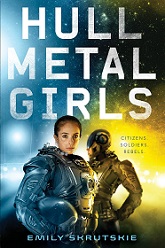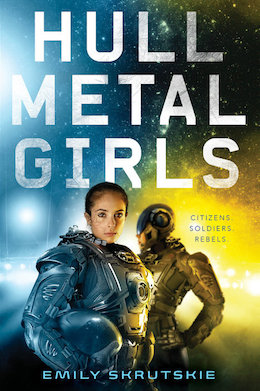Aisha Un-Haad is out of options. Her parents are dead, her brother is dying of a terrible disease, and her sister is about to start working in the dangerous dyeworks. Without money, their lives will get exponentially worse. Aisha does the only thing she can: surrender her freedom to become a mechanically enhanced soldier. Called Scelas, they are living weapons for the oppressive regime that rules the fleet of generation ships on which the last humans live.
Key Tanaka has little memory of her life before becoming a Scela or what drove her to undergo the life-threatening procedure. Aisha wants to protect her family, and Key to unlock her missing memories. In order to do that they and their teammates, willful Praava and awkward Woojin, must join the ranks of the Scela elite. But what happens when they’re ordered to kill, maim, and conspire against citizens at the behest of a corrupt leadership? Body horror, issues of consent, and body dysmorphia abound in this tense novel.
With each chapter alternating POV between Aisha and Key, the reader has plenty of time to get to know their quirks, dreams, and fears. In the beginning, I was all Aisha all the time. Key’s personality was mostly just glowering, but her counterpart had a fresh perspective and intriguing layers. By the end, however, my opinion had flip-flopped. Aisha became the taciturn, grumpy co-star while Key was bursting with energy and drive. On the other hand, Wooj and Praava lack enough character development to make their subplots click, but at least Key and Aisha have other people to bounce off of.
I could’ve also used more exploration. The concepts buttressing the worldbuilding are excellent, but we don’t get to see that much of the actual world. We’re told about how the fleet is stratified into a classist hierarchy of seven tiers, but only get solid descriptions of the interiors and societies of a couple ships. The rest are nothing more than passing names. I have no clue how many ships or people are in the fleet, or for that matter why any fleet would need to dedicate an entire ship to a dyeworks of all things. And given how vital the Scela are to the story, it’s frustrating to have our knowledge of them limited to our quartet and their supervisor. How many Scela are there? Are they mostly adults or young people? How often are Scela created? How could a fleet afford expend so many resources (especially such costly and difficult to manufacture resources) on a procedure that is rarely successful?
Skrutskie has a lot to say about classism in Hullmetal Girls. Those in the lowest tiers live in the worst conditions and do the hardest jobs all so those in the top tiers can live a life of ease and comfort. Those in power have a vested interest in maintaining the system, no matter that it means society as a whole suffers. Talk about real-world parallels.
Although the classism conversation isn’t especially new, the context in which it was placed was refreshing. There are hints of new Star Wars, The Hunger Games, Ender’s Game, The Expanse, and the Battlestar Galactica reboot. The familiarity is comforting even as it makes the plot rather predictable. I’m not convinced the final act fully supports Skrutskie’s point about classism, but if nothing else it’s action-packed and emotional.
What Hullmetal Girls does best is diversity. There’s class differences, obviously. The majority of the characters appear to be Asian and Middle Eastern. Aisha is a deeply religious even though it conflicts with her Scela enhancements. Out of the quartet, only one is cishet; the others are pansexual, trans and straight, and asexual and aromantic. There is a missed opportunity to include disabilities and mental health issues, but frankly the same could be said about just about every YA book.
Queerness often operates as a plot point in fiction, and by doing so it sets up a situation where being queer is the only thing the character is allowed to be. Intersectionality is sacrificed rather than blended in. Fortunately that is not an issue here. No one shames the queer characters, makes offensive comments, demands justifications or explanations, or tries to “fix” them. For Aisha, her religious and class identities have larger impacts on her relationship with the Scela exo—and therefore the main plot—than her sexual, romantic, or racial/ethnic identities, although all are part of who she is.
Buy the Book


Hullmetal Girls
Hugely important to me personally is the asexual and aromantic rep. Too often YA chooses one or the other—the character is either asexual and alloromantic or allosexual and aromantic, but usually the former. As an ace/aro woman of color, I practically fell out of my seat when I found out one of the protagonists is like me. Different races but still. Characters are rarely ever asexual and aromantic, and the rate reduces even further with characters of color. In Hullmetal Girls, Aisha is not only ace/aro but she is also happy with her identity. Crucially, so is everyone else. It’s super unusual for a character under the ace umbrella to simply exist with their identity, to not have to justify or explain their identity or have it challenged or discounted by others.
The book could have more deeply explored each character’s experiences with queerness without centering the plot on LGBTQ issues. And good inclusion does not excuse the shakier elements of the novel’s construction. That being said, I get so little positive ace/aro rep that I was more willing to overlook the areas where Skrutskie struggled than others might be. Hullmetal Girls isn’t perfect, but if you want queer teen cyborgs of color battling systematic oppression then you can hardly go wrong.
Hullmetal Girls is available from Delacorte Press.
Alex Brown is a YA librarian by day, local historian by night, pop culture critic/reviewer by passion, and an ace/aro Black woman all the time. Keep up with her every move on Twitter, check out her endless barrage of cute rat pics on Instagram, or follow along with her reading adventures on her blog.










